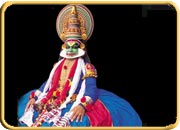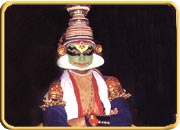Kathakali

Kathakali,
Kerala's much celebrated dance drama, keeps the connoisseurs of art awestruck.
It evolved in the 8th century from the 'Ramanattam of Kottarakkara Thampuran,
an admirer and promoter of traditional art forms. The thematic vitality of Kathakali
is sucked from Indian mythology and folklore. The themes are all those depicted
in the epics -honesty and wickedness, frailty and courage, poverty and prosperity,
war and peace.
The poetic text of the Kathakali performance is in Manipravalam, a sanskritised
form of Malayalam. While the singers vocalize scripts, the performers actually
narrate the drama through movements and gestures. Preparation for the performance
is extensive and disciplined. Final stage in the preparation is short meditation.
The self of the artiste becomes subjugated to the essence of the character.
Costumes, paint, decorated headgear help this transformation. Selection of costumes
and paints depends on the nature of the character. Red for ferocious characters,
soft pink for a beautiful character or a kind one.
Traditionally performance took place in temple grounds and while this is still
a common venue, other open-air locales as well as indoor halls are also popular.
Characters being played by artistes can be divided into:
 Pacca:
Pacca: the royal and divine characters such as Vishnu or Rama. Green
face and large headgear.
Katti: demons and villains, instance, Ravana the evil king who abducted
Sita, the legendary figure in Ramayana, the epic
Tati: red, black and white beards. the Hindu monkey god, Hanuman instrument
in assisting Rama in the search for his abducted wife Sita.
Teppu: represents human beings.
Minukku: the servant class
The performance begins with drum beating. Maddalam , the long barrel-shaped
drum that is struck at both ends to achieve a resonant rhythm. The initial drumming
performance may take up to two hours.
The rhythms of the drum beat and the style of the singer evince the temperament
of the characters ands create the mood of the drama.
The superb combination of chant, drama, dance, make-up, dress and gesture weave
a compelling spell. Performance adheres to the fundamentals and axioms laid
down by Bharata Muni, the legendary figure and the father of Indian Classical
Dances. A perfect performance demands command over body, movements and facial
expressions. The theme of the play is unravelled by the dancer through 'hasta
mudras' or hand gestures. The 'mudras' are 25 in number, whereas the 'upa mudras'
are 700. Fleeting expressions on the face and movements of the eye balls add
colour to the rendition. The best way to appreciate a Kathakali performance
is to have that particular dance-drama explained to you in advance.
Select a holiday
with us
 Kathakali,
Kerala's much celebrated dance drama, keeps the connoisseurs of art awestruck.
It evolved in the 8th century from the 'Ramanattam of Kottarakkara Thampuran,
an admirer and promoter of traditional art forms. The thematic vitality of Kathakali
is sucked from Indian mythology and folklore. The themes are all those depicted
in the epics -honesty and wickedness, frailty and courage, poverty and prosperity,
war and peace.
The poetic text of the Kathakali performance is in Manipravalam, a sanskritised
form of Malayalam. While the singers vocalize scripts, the performers actually
narrate the drama through movements and gestures. Preparation for the performance
is extensive and disciplined. Final stage in the preparation is short meditation.
The self of the artiste becomes subjugated to the essence of the character.
Costumes, paint, decorated headgear help this transformation. Selection of costumes
and paints depends on the nature of the character. Red for ferocious characters,
soft pink for a beautiful character or a kind one.
Kathakali,
Kerala's much celebrated dance drama, keeps the connoisseurs of art awestruck.
It evolved in the 8th century from the 'Ramanattam of Kottarakkara Thampuran,
an admirer and promoter of traditional art forms. The thematic vitality of Kathakali
is sucked from Indian mythology and folklore. The themes are all those depicted
in the epics -honesty and wickedness, frailty and courage, poverty and prosperity,
war and peace.
The poetic text of the Kathakali performance is in Manipravalam, a sanskritised
form of Malayalam. While the singers vocalize scripts, the performers actually
narrate the drama through movements and gestures. Preparation for the performance
is extensive and disciplined. Final stage in the preparation is short meditation.
The self of the artiste becomes subjugated to the essence of the character.
Costumes, paint, decorated headgear help this transformation. Selection of costumes
and paints depends on the nature of the character. Red for ferocious characters,
soft pink for a beautiful character or a kind one. 